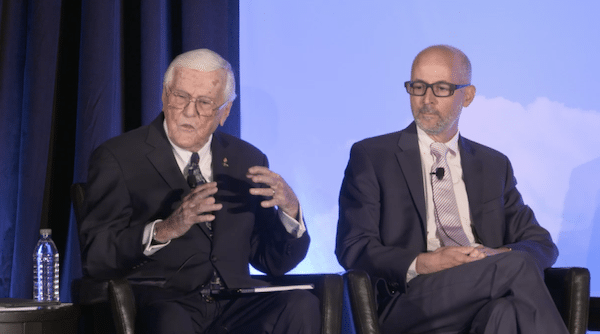
Donald Richardson, president of AIAA and Joseph Post, director of NAS systems engineering, FAA, speaking at AIAA 2018’s panel on air traffic management modernization.
With current NextGen programs and initiatives, and the interests of commercial airlines, air traffic controllers, general aviation operators, lawmakers and the integration of unmanned aircraft systems (UAS) into national airspace, there are a plethora of aviation stakeholder interests that must be satisfied in implementing the FAA’s NextGen air traffic control system modernization program.
130 different initiatives are occurring within the system of systems that is NextGen, according to a panel of experts that discussed air traffic modernization at the AIAA Aviation Forum 2018 Wednesday. While the FAA can point to ongoing progress with its Data Comm program, the implementation of 9,300 performance-based navigation (PBN) procedures and new optimized profile descent (OPD) procedures, challenges remain.
One major challenge, according to the panel, is the lack of a holistic implementation plan that considers the interests of all stakeholders.
“Our biggest concern is a lack of a clear integration plan,” said James Ullmann, director of safety and technology for the National Air Traffic Controllers Association (NATCA).
“You have commercial space, you have UAS, you have what we currently have in the NAS. How does this become one big package? The NAS is the most complex, most efficient airspace system in the world and you’re talking about making it a lot more complex,” said Ullmann.
Ullmann further highlighted the challenges with NextGen progress by showing that there is still a lot of actions that needs to be taken. He showed pictures of air traffic control facilities with computer systems that appeared to be based on 1980s technology and others where water was leaking onto equipment. The newest air traffic control tower in the NAS at San Francisco was also shown with a table full of the same type of paper-based flight progress strips that controllers first started using 60 years ago.
The comments from Ullmann were similar to perspectives from Richard Terry, director of line operations at Delta Air Lines. Terry said that the majority of the focus in terms of progress with NextGen in recent years has been on enabling benefits for commercial airlines.
“Collaboration is the single biggest thing we need to work on,” said Terry. “One of the most important things we have to take into account is the entire effort is holistic — it can’t be just commercial carriers putting new equipment on aircraft. We can go out and buy every new shiny toy and put it in the cockpit, but if there’s not an ability for ATC to take that traffic [and] move it onto the runways then it does us no good.”
While both Terry and Ullmann expressed a need for more collaboration between the various stakeholders, there is still achievement and measured progress to point to with the ongoing deployment of NextGen. The agency is currently testing the use of voice over internet protocol (VoIP) technology software at its technology research center, with the initial operational evaluation of the new National Voice System (NVS) scheduled for deployment in Seattle next year.
Elsewhere, domestic carriers continue to realize the benefits of Data Comm, with more than 39,000 controller to pilot data link communications (CPDLC) messages being transmitted per week. A total of 4,000 aircraft flying in the NAS are equipped with Data Comm avionics, and the agency is currently evaluating the use of CPDLC for en route airspace, a capability that will be introduced in November. The en route usage of CPDLC will allow controllers to issue re-routes digitally instead of verbally for the first time in domestic airspace.
“Right now we’re in testing in Indianapolis, and over the next 18 months, CPDLC is going to roll out nationwide and have an huge impact on NAS,” said Terry.
From the FAA’s perspective, the next major goal for NextGen is the achievement of trajectory-based operations (TBO). The FAA defines TBO as a concept of air traffic operations that allows pilots and controllers to decrease the uncertainty associated with an aircraft’s flight path in four dimensions, including latitude, longitude, altitude and time. Through the combined use of Data Comm, PBN and ADS-B, the improved shared knowledge in the position updates of aircraft will lead to a more consistent view of the four-dimensional trajectory of an aircraft throughout the NAS.
“The next big thing for NextGen is trajectory based operations; that’s what everybody is talking about,” said Joseph Post, director of NAS system engineering and integration for the FAA. “TBO relies on two things: PBN and time-based management. The idea is to use precision paths, precision navigation and a common trajectory between ATC, cockpit and FAA automation systems to keep aircraft on precise 4-D trajectories.”